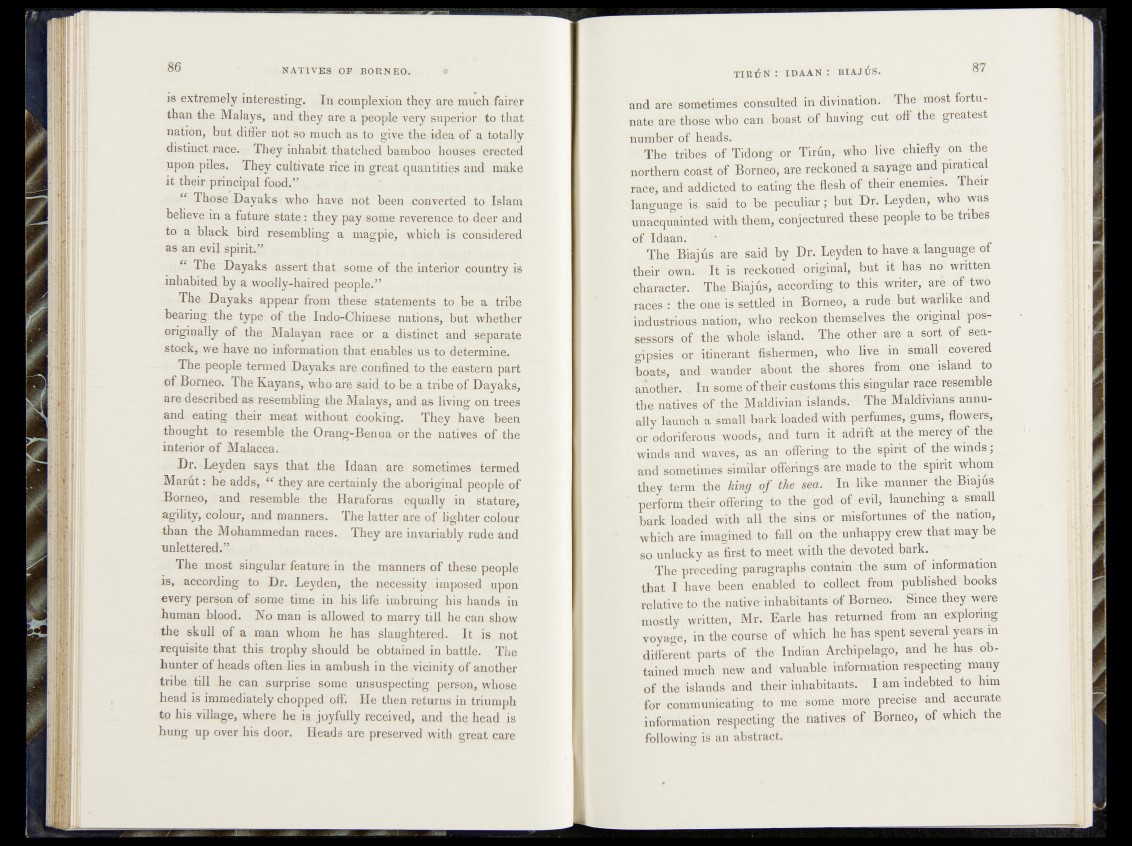
is extremely interesting. In complexion they are much fairer
than the Malays, and they are a people very superior to that
nation, but differ not so much as to give the idea of a totally
distinct race. They inhabit thatched bamboo houses erected
npon piles. They cultivate rice in great quantities and make
it their principal food.”
“ Those Dayaks who have not been converted to Islam
believe in a future state: they pay some reverence to deer and
to a black bird resembling a magpie, which is considered
as an evil spirit;”
“ The Dayaks assert that some of the interior country is
inhahited by a woolly-haired people.”
The Dayaks appear from these statements ,to be a tribe
bearing, the type of the Indo-Chinese nations, but whether
originally of the Malayan race or a distinct and separate
stock, we haye no information that enables us to determine.
The people termed Dayaks are confined to the eastern part
of Borneo. The Kayans, who are said to be a tribe of Dayaks,
are described as resembling the Malays, and as living on trees
and eating their meat without booking. They have been
thought to resemble the Orang-Benua or the natives of the
interior of Malacca.
Dr. Leyden says that the Idaan are sometimes termed
Marut: he adds, “ they are certainly the aboriginal.people of
Borneo, and resemble the Haraforas equally in stature,
agility, colour, and manners. The latter are of lighter colour
than the Mohammedan races. They are invariably rude and
unlettered.”
The most singular feature in the manners of these people
is, according to Dr. Leyden, the necessity imposed upon
every person of some time in his life imbruing his hands in
human blood. No man is allowed to marry till he can show
the skull of a man whom he has slaughtered. It is not
requisite that this trophy should he obtained in battle. The
hunter of heads often dies in ambush in the, vicinity of another
tribe,, till he can surprise some unsuspecting person, whose
head is immediately chopped off. He then returns in triumph
to his village, where he is joyfully received, and the head is
hung up over his door. Heads are preserved with great care
and are sometimes consulted in divination. The most fortunate
are those who can boast of having cut off the greatest
number of heads.
The tribes of TMong or Tirûn, who live chiefly on the
northern coast of Borneo? are reckoned a sayage and piratical
race, and-addicted to eating the flesh of'their enemies. Their
language is said to be peculiar biit Dr. Leyden,' who was
unacquainted with them, conjectured these people to be tribes
of Idaan. • -
The Biajus are said by Dr: Leyden to have a language“ of
their own. It is reckoned original, buit it haS‘ no written
character. The Biajfis, according to- this writer, are of two
racqs 1 the one is settled in Borneo, a rude but warhk^and
industrious nation, who reckon themsèlves the original possessors
of the whole‘island. The other areAa, soft of sea-
gipsies or itinerant fishermen, who live in small covered
boats, and wander about the shores fróm onè ’island to
another. ^ In some of their customs this singular race resemble
the natives of thé Maldivian islands/ The M-aMvianS'annually
launch a 'small-bark loaded with perfumes^gums, flowers,
or odoriferous woods, and turn it adrift at the mercy of the
’ winds and waves, as an offeririg to the spirit óf the winds ;
and sometimes similar offerings are made to the spirit whom
they term'the king o f the sea. In like mànhër the Bluffs
" perform their offering to the god of evil, launching a small
bark loaded with all the sins or misfortunes of the nation,
which are imagined to fall on the unhappy crew that may be
so unlucky as first to meet with the devoted bark. !jgj
The preceding paragraphs contain the sum. of information
that I have been enabled to collect from published books
relative to the native inhabitants of Borneo. 'Since they were
mostly written, Mr. Earle-has returned from an exploring
voyage, in the course of which he has spent several years in
different parts of the Indian Archipelago, and he has obtained
much new and valuable information respecting many
of the islands and their inhabitants; I am indebted to him
for communicating to me some more precise and accurate
information respecting the natives of Borneo, of which the
following is an abstract.